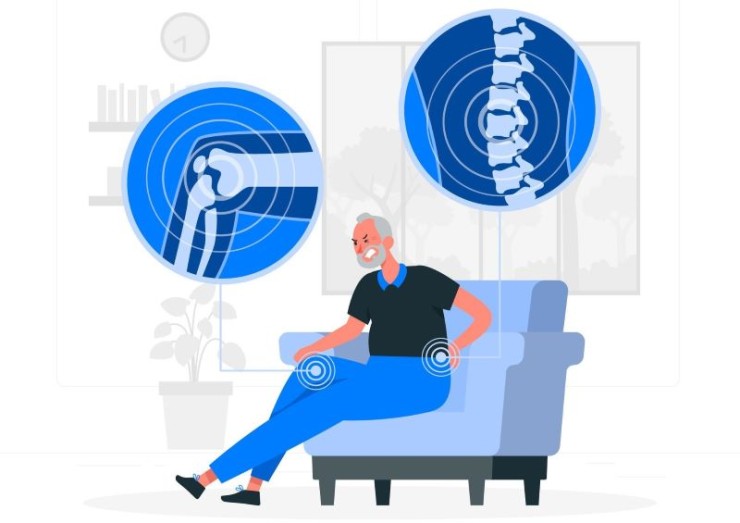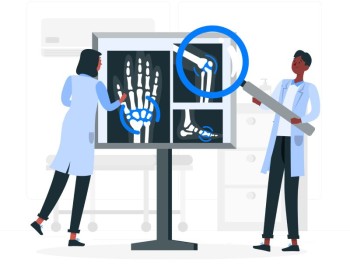
A DEXA scan, conducted with a focus on a specific part of the body, is a meticulous diagnostic tool designed for an in-depth assessment of bone health.
Dexa Scan or BMD Test in India with Cost
DEXA Scan (Single-Part Focus) - Detailed Analysis:
A DEXA scan, conducted with a focus on a specific
part of the body, is a meticulous diagnostic tool designed for an in-depth
assessment of bone health. This advanced imaging technique, utilizing
Dual-Energy X-ray Absorptiometry, delivers a detailed analysis of bone mineral
density (BMD) in the targeted region, ensuring precision and clinical relevance.
Procedure Overview:
· The patient is
positioned on an examination table, usually lying on their back.
· The DEXA scanner,
equipped with dual-energy X-ray beams, precisely targets the chosen area, such
as the spine, hip, or forearm.
· The scan is swift, taking only a few minutes, and involves minimal radiation exposure.
High-Resolution Imaging:
· DEXA technology provides high-resolution images, allowing for a granular examination of bone composition.
· The scanner discerns between bone and soft tissue, offering a clear view of the mineral density in the selected part
Quantitative Assessment:
· The results are quantified using a T-score, which compares the patient's bone density to that of a healthy young adult.
· Negative T-scores may indicate lower bone density, signifying conditions like osteoporosis.
Clinical Significance:
· The detailed analysis facilitates the early detection of conditions affecting the targeted area.
· Healthcare professionals
can identify potential fracture risks and formulate precise interventions for
improved bone health.
Tailored Interventions:
· The specific focus of
the DEXA scan allows for personalized treatment plans, addressing localized
issues identified during the examination.
· Clinicians can recommend
targeted interventions, such as lifestyle changes or medication, based on the
detailed analysis.
Bone Mineral Density Test (Single-Part Focus) - Detailed Analysis:
A Bone Mineral Density (BMD) test, concentrating on a single part of the body, involves a comprehensive evaluation of bone health using various techniques. This detailed analysis aims to provide nuanced insights into bone density and potential issues specific to the examined region.
Multifaceted Techniques:
·
BMD tests may employ diverse methods, including DEXA, quantitative
ultrasound, or quantitative computed tomography, based on the specific clinical
requirements.
Localized Assessment:
·
The examination focuses on a particular area, allowing for a detailed
assessment of bone density within that region.
·
Each technique contributes unique data points, enhancing the overall
understanding of bone health.
Numerical Representation:
·
Results are typically presented as T-scores or Z-scores, offering
numerical values that compare the individual's bone density to a reference
population.
Early Detection:
·
The nuanced analysis assists in the early identification of localized
bone-related conditions, such as osteopenia or other disorders impacting the
chosen part.
Individualized Care:
· The information obtained from the BMD test enables healthcare professionals to tailor interventions and treatments to address the specific needs of the patient, promoting targeted care.
In summary, both the DEXA scan and the BMD test with a single-part focus provide intricate and clinically valuable analyses of bone health. These detailed assessments empower healthcare providers with the information needed to make informed decisions regarding interventions and treatments, fostering proactive management of bone-related conditions.
Frequently Asked Questions (FAQs) for DEXA Scan and BMD Test Single-Part
Focus:
1. What is a DEXA scan, and how does it differ from a Bone Mineral Density (BMD) test?
Answer:
A DEXA scan is a diagnostic imaging technique that measures bone mineral
density using dual-energy X-ray absorptiometry. It is a type of BMD test, but
not all BMD tests use DEXA. DEXA is a specific technology within the broader
category of BMD testing.
2. Why would a healthcare provider recommend a DEXA scan or BMD test
with a single-part focus?
Answer: These tests are recommended to assess bone health in a specific area, like the spine, hip, or forearm. They are particularly useful for diagnosing conditions such as osteoporosis, identifying fracture risks, and tailoring interventions based on localized bone health.
3. Are DEXA scans and BMD tests painful or invasive?
Answer: No, both procedures are non-invasive and generally painless. Patients lie on an examination table, and the scanning equipment is used to capture images or measure bone density. There's minimal discomfort, and the procedures are relatively quick.
4. How long does a DEXA scan or BMD test take?
Answer: Typically, both procedures take only a few minutes to complete. The actual duration may vary based on the specific technique used and the targeted body part.
5. Is there any preparation required before a DEXA scan or BMD test?
Answer: Usually, there's no special preparation. Patients may be advised to wear comfortable clothing without metal objects. It's essential to inform the healthcare provider about any medications or conditions that might affect the results.
6. What do T-scores and Z-scores represent in the results of these tests?
Answer: T-scores compare an individual's bone density to that of a healthy young adult, while Z-scores compare it to an age-matched population. Negative T-scores may indicate lower bone density and an increased risk of fractures.
7. How often should someone undergo a DEXA scan or BMD test for a
specific body part?
Answer: The frequency depends on various factors, including age, gender, medical history, and risk factors. Healthcare providers will recommend the appropriate schedule based on an individual's specific circumstances.
8. Can these tests detect conditions other than osteoporosis?
Answer: Yes, they can. DEXA scans and BMD tests can identify conditions like osteopenia, which is lower than normal bone density but not as severe as osteoporosis. They also assist in assessing overall bone health, aiding in the detection of various bone-related disorders.
9. Are there any risks associated with DEXA scans or BMD tests?
Answer: Both procedures involve minimal radiation exposure, and the benefits of obtaining crucial diagnostic information typically outweigh the potential risks. Pregnant women should inform their healthcare provider before undergoing these tests.
10. How do the results influence treatment decisions?
Answer: The detailed analysis from these tests guides healthcare providers in formulating personalized treatment plans. It helps in recommending lifestyle changes, dietary adjustments, or medications to improve bone health and reduce the risk of fractures based on the individual's specific needs.
(0)
Login to continue



